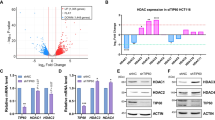Abstract
JMY is a p300-binding protein with dual action: by enhancing P53 transcription in the nucleus, it plays an important role in the cellular response to DNA damage, while by promoting actin filament assembly in the cytoplasm; it induces cell motility in vitro. Therefore, it has been argued that, depending of the cellular setting, it might act either as tumor suppressor or as oncogene. In order to further determine its relevance to human cancer, we produced the monoclonal antibody HMY 117 against a synthetic peptide from the N-terminus region and characterized it on two JMY positive cell lines, MCF7 and HeLa, wild type and after transfection with siRNA to switch off JMY expression. JMY was expressed in normal tissues and heterogeneously in different tumor types, with close correlation between cytoplasmic and nuclear expression. Most noticeable was the loss of expression in some infiltrating carcinomas compared to normal tissue and in in situ carcinomas of the breast, which is consistent with a putative suppressor role. However, as in lymph node metastases, expression of JMY was higher than in primary colorectal and head and neck carcinomas, it might also have oncogenic properties depending on the cellular context by increasing motility and metastatic potential.



Similar content being viewed by others
References
Shikama N, Lee CW, France S, Delavaine L, Lyon J, Krstic-Demonacos M, La Thangue NB (1999) A novel cofactor for p300 that regulates the p53 response. Mol Cell 4(3):365–376
Coutts AS, La Thangue NB (2007) Mdm2 widens its repertoire. Cell Cycle 6(7):827–829
Hershko T, Chaussepied M, Oren M, Ginsberg D (2005) Novel link between E2F and p53: proapoptotic cofactors of p53 are transcriptionally upregulated by E2F. Cell Death Differ 12(4):377–383. doi:10.1038/sj.cdd.4401575
Coutts AS, Boulahbel H, Graham A, La Thangue NB (2007) Mdm2 targets the p53 transcription cofactor JMY for degradation. EMBO Rep 8(1):84–90. doi:10.1038/sj.embor.7400855
Zuchero JB, Coutts AS, Quinlan ME, Thangue NB, Mullins RD (2009) p53-cofactor JMY is a multifunctional actin nucleation factor. Nat Cell Biol 11(4):451–459. doi:10.1038/ncb1852
Campellone KG, Welch MD (2010) A nucleator arms race: cellular control of actin assembly. Nat Rev Mol Cell Biol 11(4):237–251. doi:10.1038/nrm2867
Rottner K, Hanisch J, Campellone KG (2010) WASH, WHAMM and JMY: regulation of Arp2/3 complex and beyond. Trends Cell Biol 20(11):650–661. doi:10.1016/j.tcb.2010.08.014
Coutts AS, Pires IM, Weston L, Buffa FM, Milani M, Li JL, Harris AL, Hammond EM, La Thangue NB (2011) Hypoxia-driven cell motility reflects the interplay between JMY and HIF-1alpha. Oncogene. doi:10.1038/onc.2011.188
Coutts AS, Weston L, La Thangue NB (2009) A transcription co-factor integrates cell adhesion and motility with the p53 response. Proc Natl Acad Sci U S A 106(47):19872–19877. doi:10.1073/pnas.0906785106
Bates GJ, Fox SB, Han C, Launchbury R, Leek RD, Harris AL, Banham AH (2008) Expression of the forkhead transcription factor FOXP1 is associated with that of estrogen receptor-beta in primary invasive breast carcinomas. Breast Cancer Res Treat 111(3):453–459. doi:10.1007/s10549-007-9812-4
Coutts AS, Weston L, La Thangue NB (2010) Actin nucleation by a transcription co-factor that links cytoskeletal events with the p53 response. Cell Cycle 9(8):1511–1515
Roadcap DW, Bear JE (2009) Double JMY: making actin fast. Nat Cell Biol 11(4):375–376. doi:10.1038/ncb0409-375
Wang Y (2010) JimMY on the stage: linking DNA damage with cell adhesion and motility. Cell Adh Migr 4(2):166–168
Firat-Karalar EN, Hsiue PP, Welch MD (2011) The actin nucleation factor JMY is a negative regulator of neuritogenesis. Mol Biol Cell 22(23):4563–4574. doi:10.1091/mbc.E11-06-0585
Saadi A, Shannon NB, Lao-Sirieix P, O'Donovan M, Walker E, Clemons NJ, Hardwick JS, Zhang C, Das M, Save V, Novelli M, Balkwill F, Fitzgerald RC (2010) Stromal genes discriminate preinvasive from invasive disease, predict outcome, and highlight inflammatory pathways in digestive cancers. Proc Natl Acad Sci U S A 107(5):2177–2182. doi:10.1073/pnas.0909797107
Zuchero JB, Belin B, Mullins RD (2012) Actin binding to WH2 domains regulates nuclear import of the multifunctional actin regulator JMY. Mol Biol Cell 23(5):853–863. doi:10.1091/mbc.E11-12-0992
Acknowledgments
This work was in part funded by the Pathological Society of Great Britain and in part by Cancer Research UK.
Conflict of interest statement
We declare that we have no conflict of interest.
Author information
Authors and Affiliations
Corresponding author
Additional information
Ethic approval numbers: C02.216 The pathobiology of neoplasia in human tissues
PPL 30/2606 production of monoclonal antibodies in mice
Rights and permissions
About this article
Cite this article
Adighibe, O., Turley, H., Leek, R. et al. JMY protein, a regulator of P53 and cytoplasmic actin filaments, is expressed in normal and neoplastic tissues. Virchows Arch 465, 715–722 (2014). https://doi.org/10.1007/s00428-014-1660-0
Received:
Revised:
Accepted:
Published:
Issue Date:
DOI: https://doi.org/10.1007/s00428-014-1660-0




